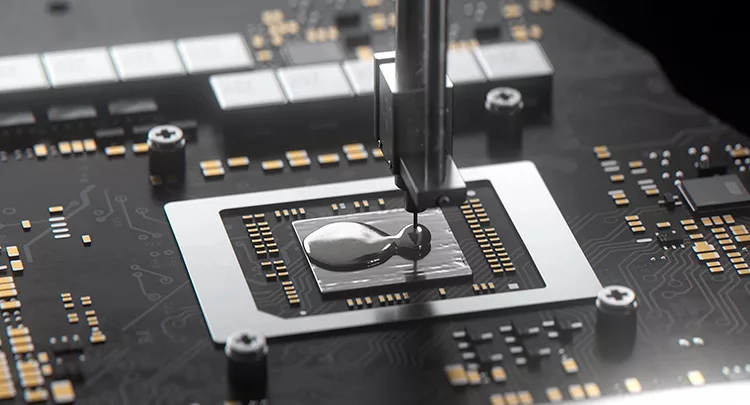The super slim ROG Zephyrus S GX701 takes gaming on the go to new heights
Gaming laptops are often big and bulky, designed to travel from one wall socket to the next. Although they’re packed with fast mobile hardware, big-time rendering muscle chews through battery power too quickly. As an unfortunate consequence, they typically lack stamina on the go, turning them into workstations you pack into a bag and lug between LAN parties.
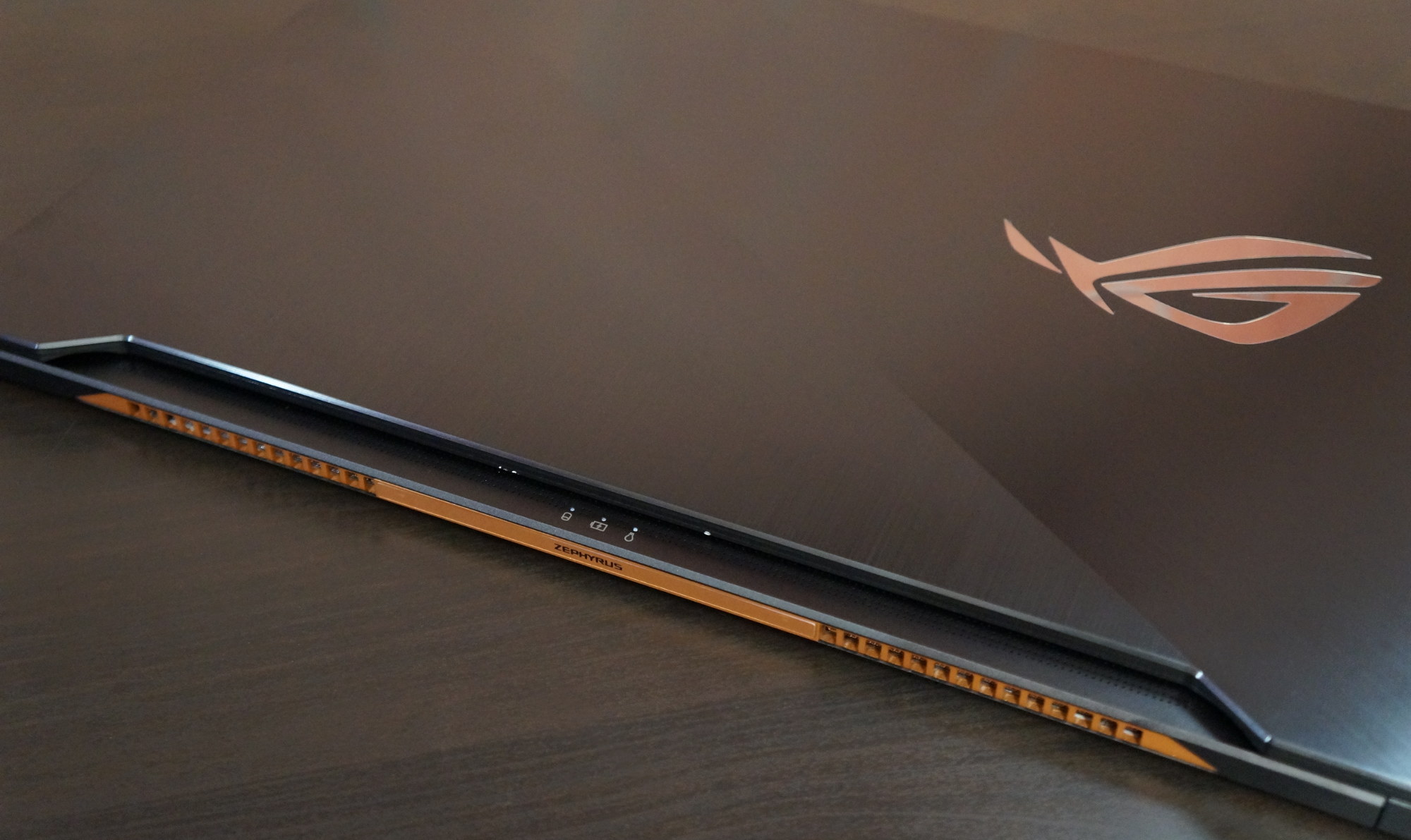
ROG’s Zephyrus S GX701 breaks that stereotype into a million little pieces. It’s not just a repository for go-fast parts. Premium materials, tasteful lighting, and an ergonomic layout reflect decisions made to improve the mobile experience, even as it outperforms the rest of the pack.
This is no clumsy brute. It’s a hybrid sports car in every sense of the metaphor, complete with an unprecedented top speed thanks to a six-core 8th-gen Intel CPU and NVIDIA GeForce RTX graphics; as well as features to maximize mileage, like NVIDIA Optimus technology. We’ve added every performance package on the option list, including NVMe SSDs and DDR4-2666 memory, and plenty of creature comforts like per-key RGB lighting and Aura Sync support.
Turning heads with unquestionable class
It’s clear there’s something special about the Zephyrus S GX701 the moment you sit down to unbox it. Lifting the lid on the packaging pushes the cardboard underneath the laptop up in a fluid gesture that simultaneously presents the magnesium-aluminum body and foreshadows one of the GX701’s most important features: its Active Aerodynamic System, which facilitates the airflow needed to cool a chassis full of high-end hardware. You pull the system out, tear off the protective plastic wrapped crisply around its beveled edges, and wonder how more than 140W of Core i7 CPU and GeForce RTX graphics actually fit inside.
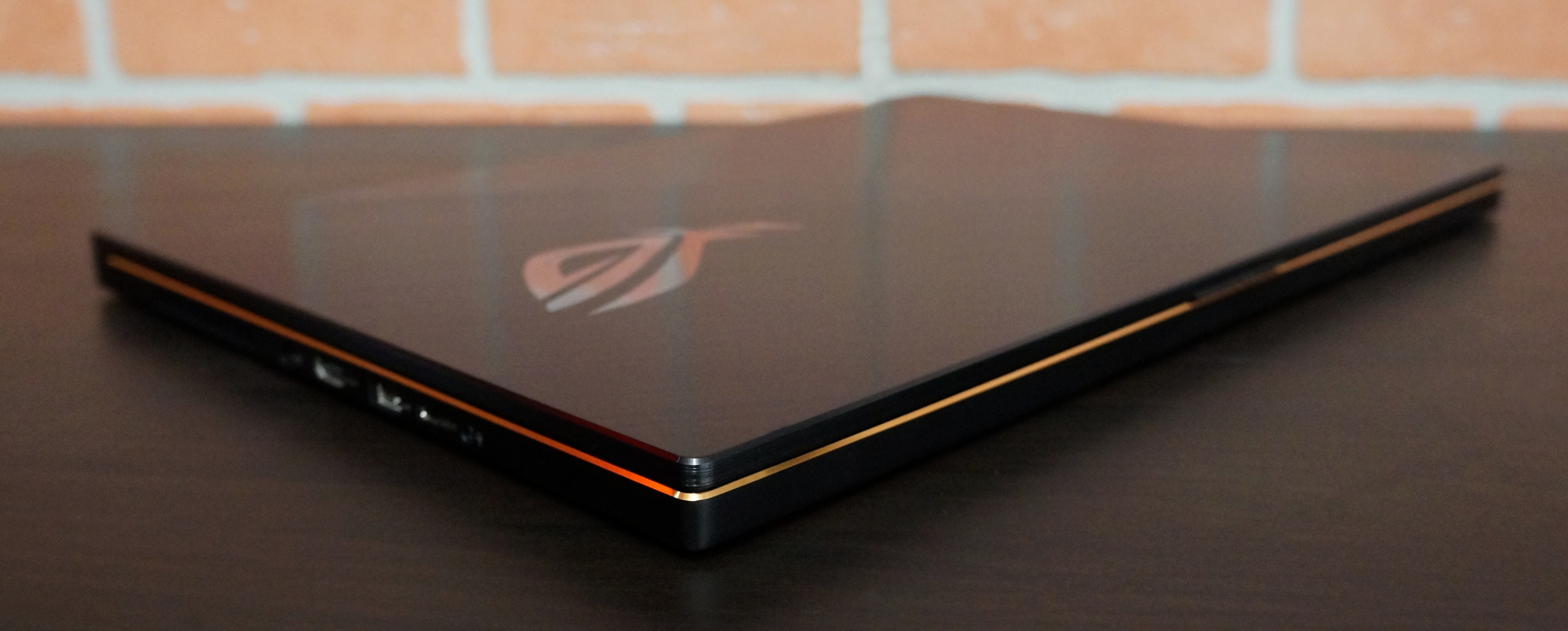
Closed, the chassis looks like something you’d snatch off the table with one hand and tuck under your arm on the way out the door to class. It’s so far removed from a typical high-end gaming notebook, and yet it’d take a well-appointed desktop PC to outperform it. The body measures just 15.7” wide, 10.7” deep, and a scant 0.7” thick. It slid right into most of the backpacks and laptop bags around my house. Moreover, the sub-6 lb frame is actually comfortable to carry around. This is no featherweight—after all, there’s a lot of advanced tech under the hood—but the GX701 is far more svelte than its specs suggest.
Crack open the lid and you’re treated to tiny bezels framing an expansive display. Narrow 6.9-mm edges along the top and sides serve to amplify the grandeur of a 17.3” panel in a form factor commonly associated with 15” designs. And yet, the frame is sturdy. On many laptops I’ve tested, the lid flexes as it moves. Not so on the GX701. Pinching a corner between two fingers and working the hinge back and forth demonstrates how well the materials resist bending. And when you finally allow the top to snap shut, a thin foam lip absorbs the impact with a soft thud.
Diamond-cut anodized edges on the Zephyrus S’ bottom half soften its squared-off shape. They’re just thick enough to catch light from overhead, casting copper-colored reflections and livening up the brushed black top cover.
A feast for the eyes
It’s only after sinking big bucks into a high-end PC that many gamers realize they’re under-served by an aging monitor. But ROG’s Zephyrus S GX701 ensures your panel technology keeps pace with the latest and greatest enthusiast hardware. Its IPS-class screen is Pantone Validated, which means the display is calibrated at the factory to faithfully reproduce Pantone Matching System colors. The result is a crisp, vibrant output. None of the other monitors or mobile devices in my lab are calibrated, and I was able to walk around with the GX701 and compare them side-by-side. In each case, I found myself trying to match their settings to the Zephyrus S.
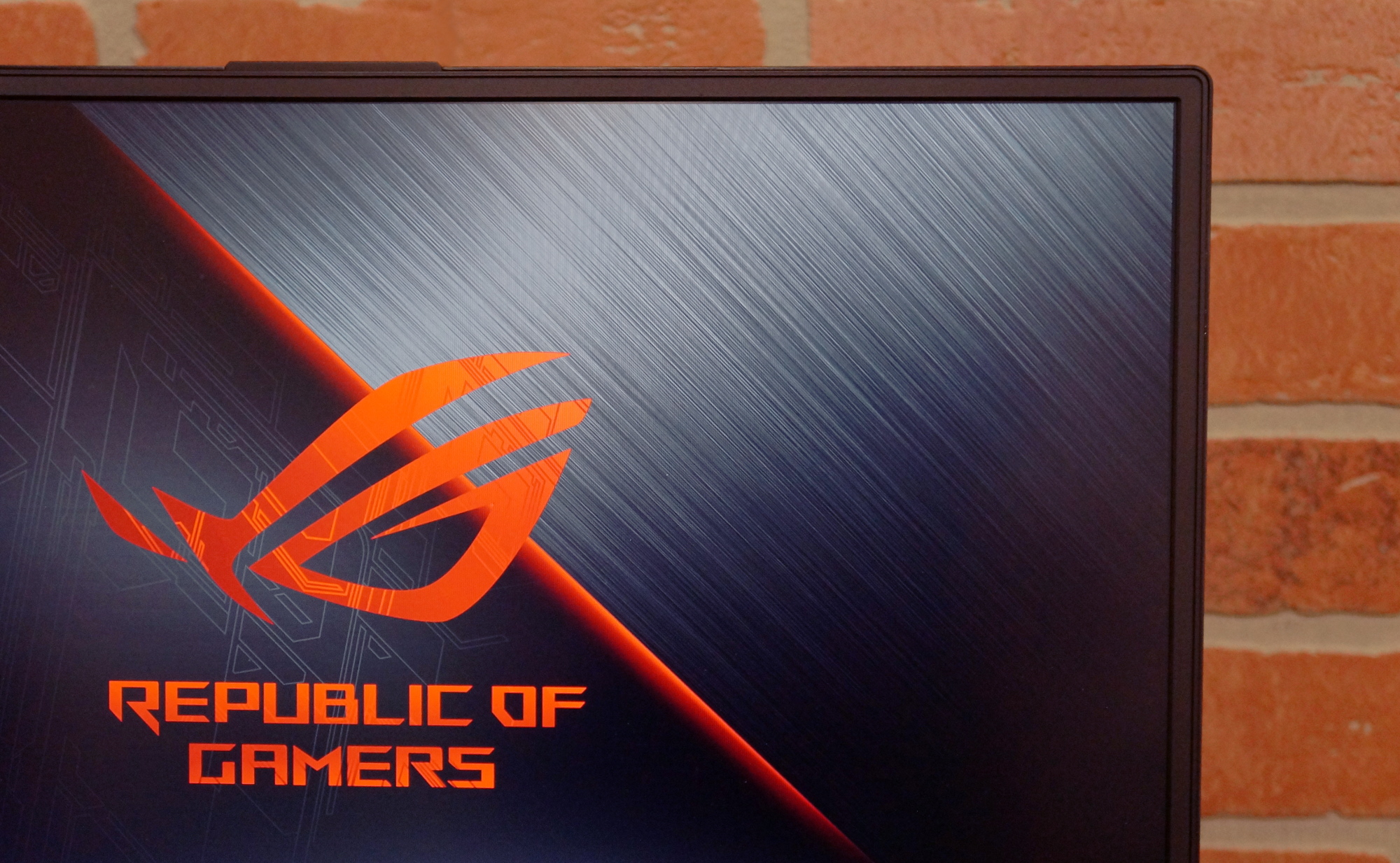
Granted, true-to-life color is a more perceivable benefit with other, lesser devices close at hand. But you don’t need a point of reference to appreciate the Zephyrus S GX701’s 144Hz refresh rate or 3ms gray-to-gray response time. On my desktop, I’m used to quickly dragging the mouse across three screens and seeing the cursor jump between monitor refresh cycles. It’s part of what we all grew up accustomed to during the age of 60Hz refresh rates. On a 144Hz display, though, this just isn’t a thing. Motion is decidedly more fluid. It’s also free of the ghosting artifacts that plague less responsive panels.
Diminutive bezels complement the quick refresh and low response time to heighten immersion. It’s difficult to explain why skinny edges make gaming on a 17.3” display so much more engaging, except to say that they amplify the panel’s size. Particularly from two feet away, an 81% screen-to-body ratio means the panel occupies more of your field of view.
The best graphics money can buy
Big, beautiful displays truly stand out when they’re driven by equally accomplished graphics processors. That’s why the ROG Zephyrus S GX701 is available with GeForce RTX graphics up to the RTX 2080. All members of the RTX family support for the latest real-time ray tracing and AI-driven performance-enhancing technologies through NVIDIA’s Turing architecture.
Our sample came armed with the flagship GeForce RTX 2080, based on a 13.6 billion-transistor TU104 chip. Its 2,944 CUDA cores and 8GB of GDDR6 memory match the desktop version, but the sophisticated GPU is optimized for peak performance in thin laptop form factors. Generally, that requires fine-tuning clock rates to abide a power limit dictated by the system’s ability to dissipate heat. Because our Zephyrus S is all about cooling high-end hardware in a compact footprint, we’re able to push the GeForce up to 100W with a peak GPU Boost frequency of 1,230 MHz, which is faster than similarly slim gaming laptops.
Compromise is not a word in this graphics solution’s vocabulary; we fired up a series of AAA titles and recorded nothing short of exceptional experiences in all of them using a combination of OCAT and PresentMon.
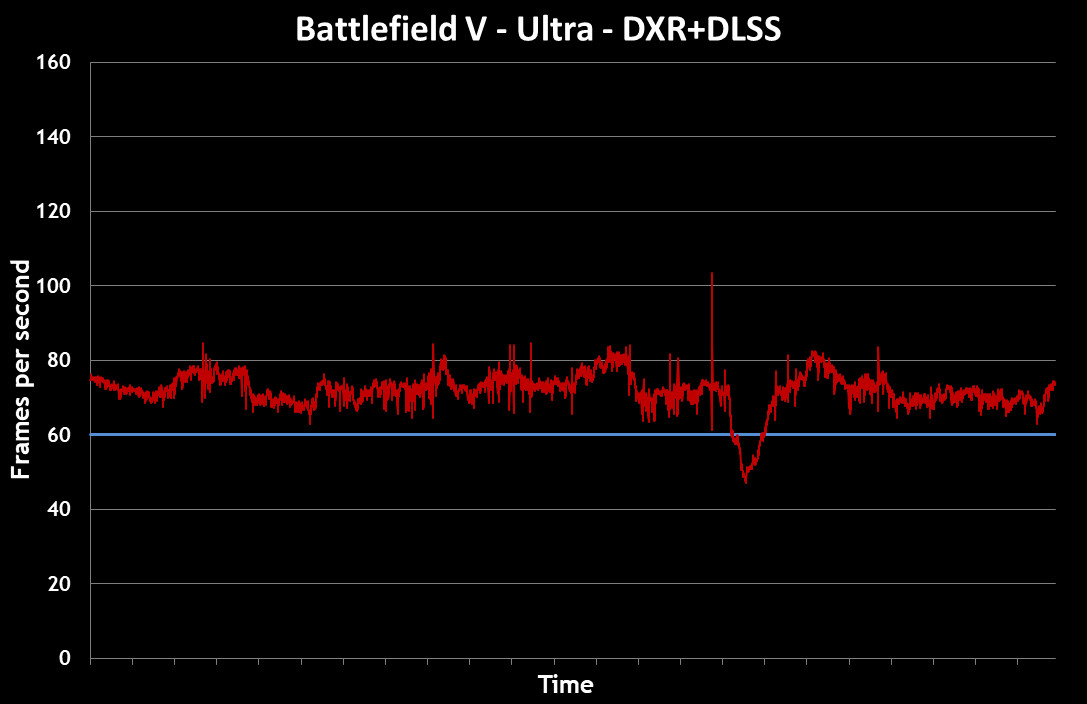
First, we set Battlefield V to its Ultra quality preset at the 17.3” panel’s native resolution. We made sure to enable DXR for ray-traced reflections and NVIDIA’s DLSS technology to help improve performance. Across our benchmark sequence, frame rates mostly remained above 60 FPS. There’s one brief scene where we create as much chaos as possible with exploding barrels on wet ground, yielding a worst-case dip into the high-40 FPS range. Otherwise, though, the game averages 70+ FPS with realism maxed out.
The Zephyrus S’ sound in Battlefield V played its part in a particularly impressive display of entertainment. Explosions weren’t just loud; they concussed as well, sending low-frequency ripples through my desk. Even on carpet, ROG’s smart amplifier tech and upward-firing 2.5W speakers sounded great.
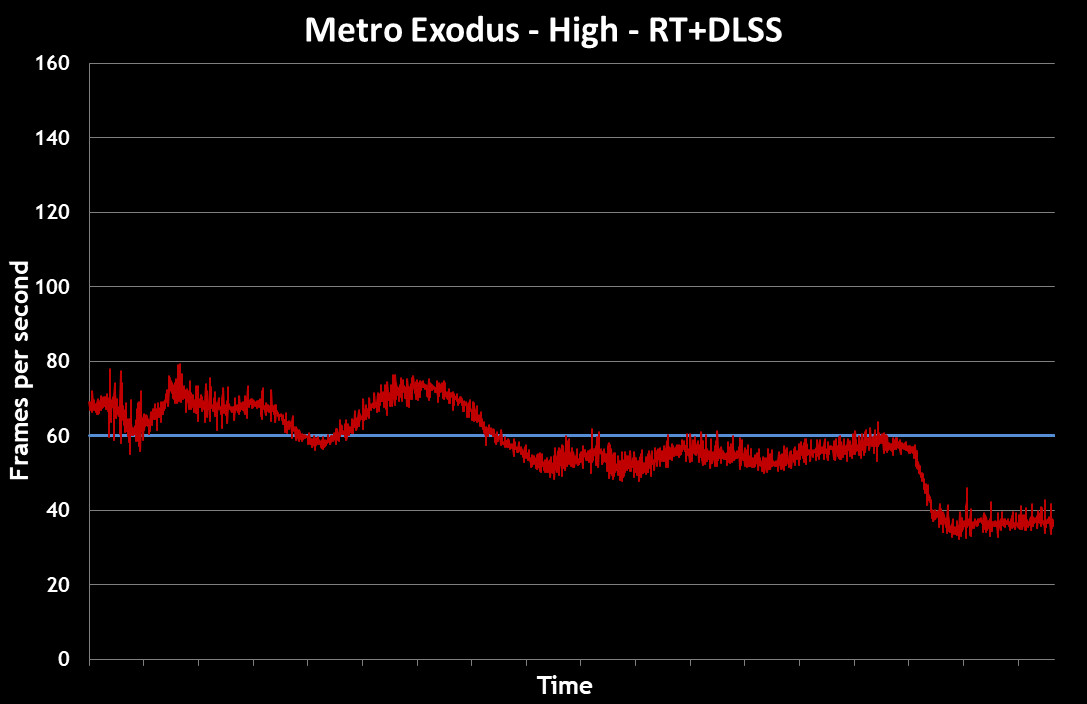
Metro Exodus is another brand new, cutting-edge game that leverages RTX technologies to increase realism. Whereas Battlefield uses ray tracing for gorgeous reflections, Metro implements it for spooky global illumination. The game is immensely demanding as a result. However, even with its quality preset at High, tessellation cranked up, ray tracing set to High, and DLSS turned on, we still observed consistently low frame times and smooth performance. This is where the benefit of G-Sync is most apparent. Rather than experiencing tearing or stuttering on either side of 60 FPS, the GPU and panel work cooperatively to show frames when they’re ready.
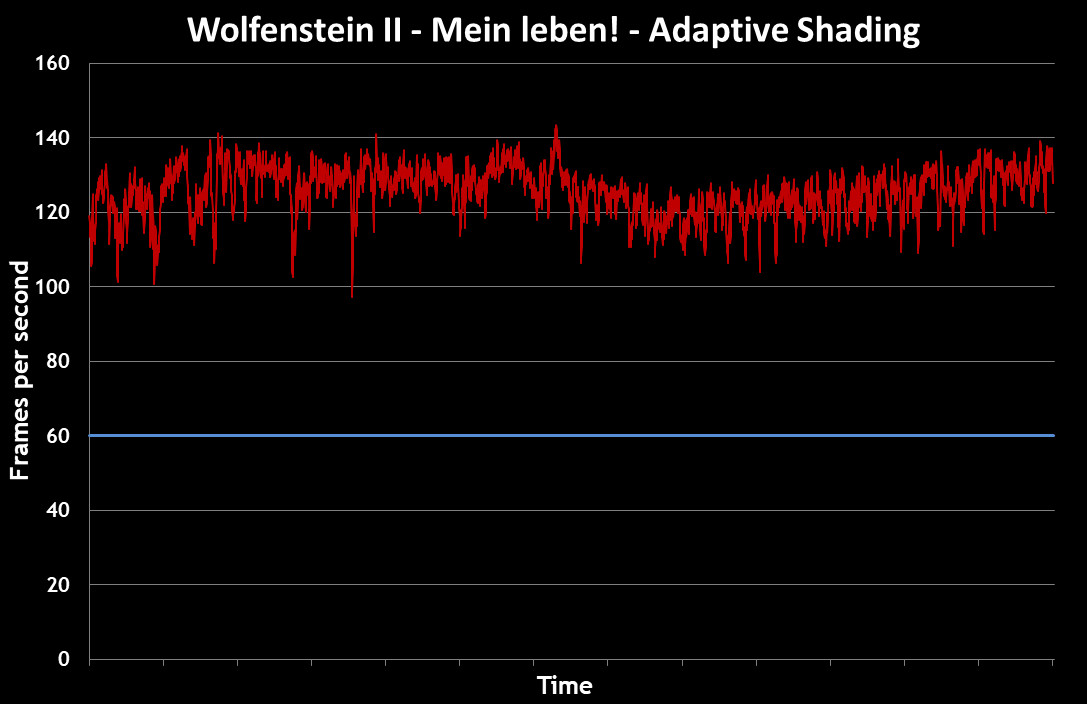
Beyond the GeForce RTX family’s RT and Tensor cores, enabling ray tracing and DLSS, all Turing-based GPUs also support a set of algorithms for optimizing shader work. These fall under the Adaptive Shader umbrella and do require effort from game developers to implement. But they can yield big speed-ups without affecting image quality. In Wolfenstein II: The New Colossus, we set the game’s detail preset to its highest level, dialed Adaptative Shading to its Balanced option, and enjoyed triple-digit frame rates that showcased the 144Hz display.
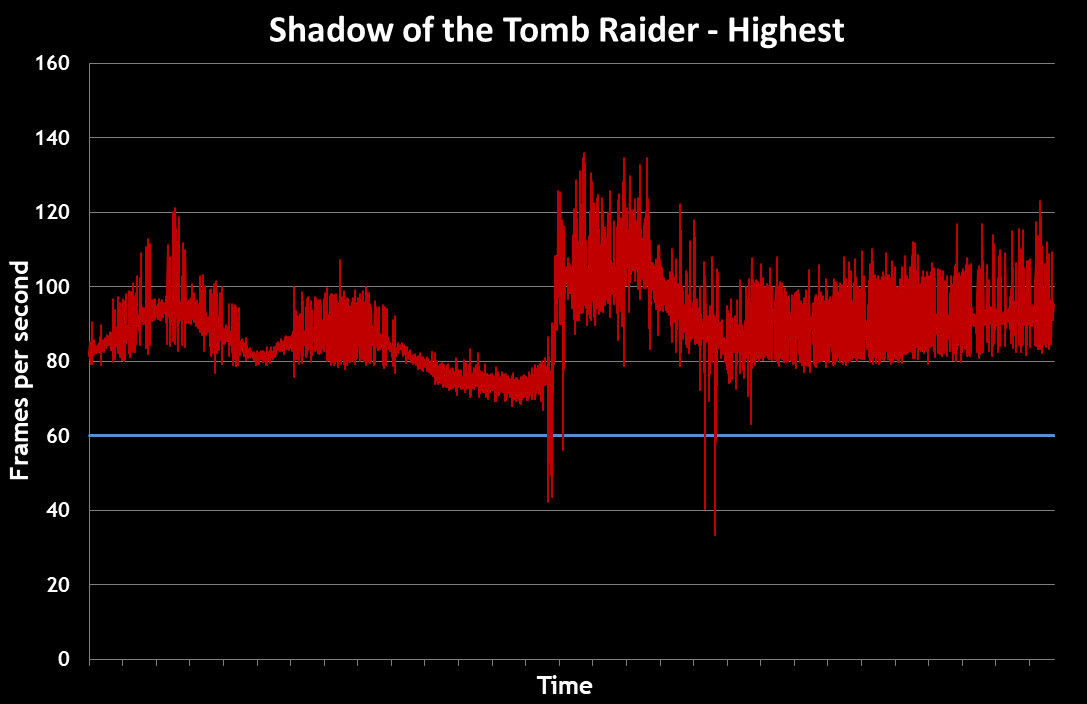
Performance generally hovers above 80 FPS in Shadow of the Tomb Raider configured to run at its best-looking quality preset. Small dips in our line chart correspond to scene changes during the game’s built-in benchmark. Otherwise, this title runs exceptionally well with a GeForce RTX 2080 at the wheel.
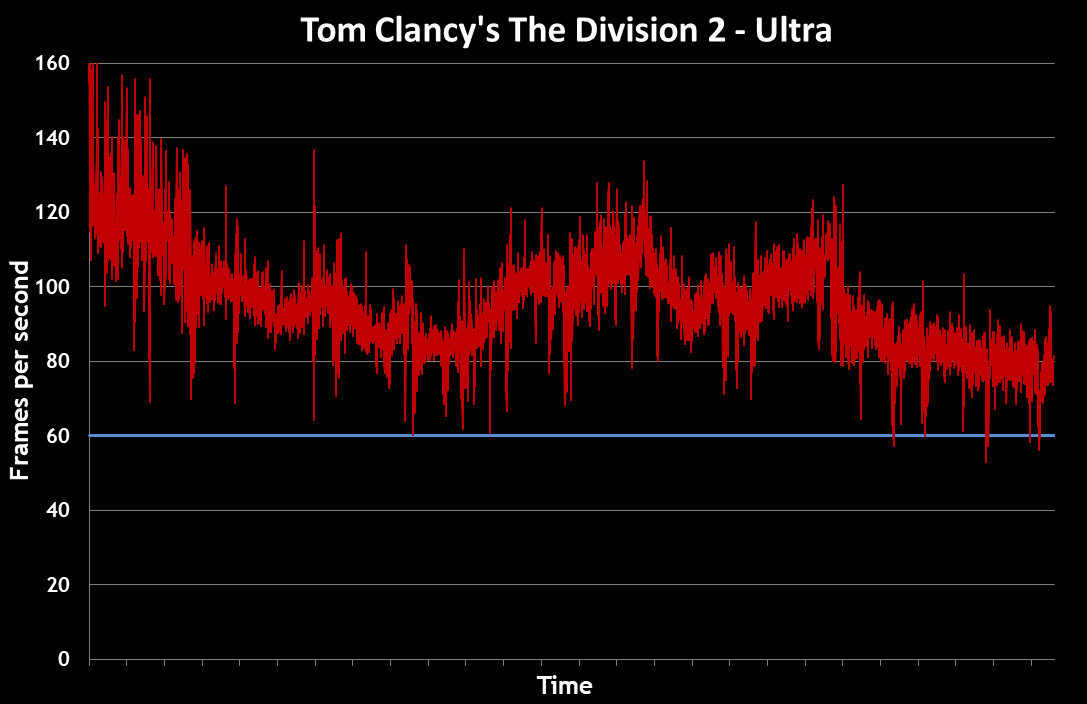
Tom Clancy’s The Division 2 isn’t optimized for any specific NVIDIA technology, yet this just-released sequel serves up smooth frame rates, even when we use its Ultra preset. An integrated benchmark sequence illustrates GPU and CPU utilization—93% and 86%, respectively. We can see from this data that the GeForce RTX 2080 and six-core Core i7-8750H are well-matched. Neither component sits idle while the other works. It’s difficult to create such harmonious balance in a desktop PC. That ROG achieved it with the Zephyrus S GX701 is downright surgical.
It’s all in the presentation
The decision to use AU Optronics glass with a 1920x1080 native resolution is part of our continued efforts to push the boundaries for laptop displays as well as gaming on the go. Those dimensions multiply out to more than 2 million pixels per frame, or 124 million pixels per second for a steady 60 FPS. Matching a 144Hz refresh rate means sustaining almost 300 million pixels per second. Even for the GeForce RTX 2080, literally the fastest graphics solution available for thin gaming notebooks, that’s a lot of work. Higher-resolution screens require even more GPU horsepower, so 1920x1080 is perfect for the performance levels we want to see in the GX701.
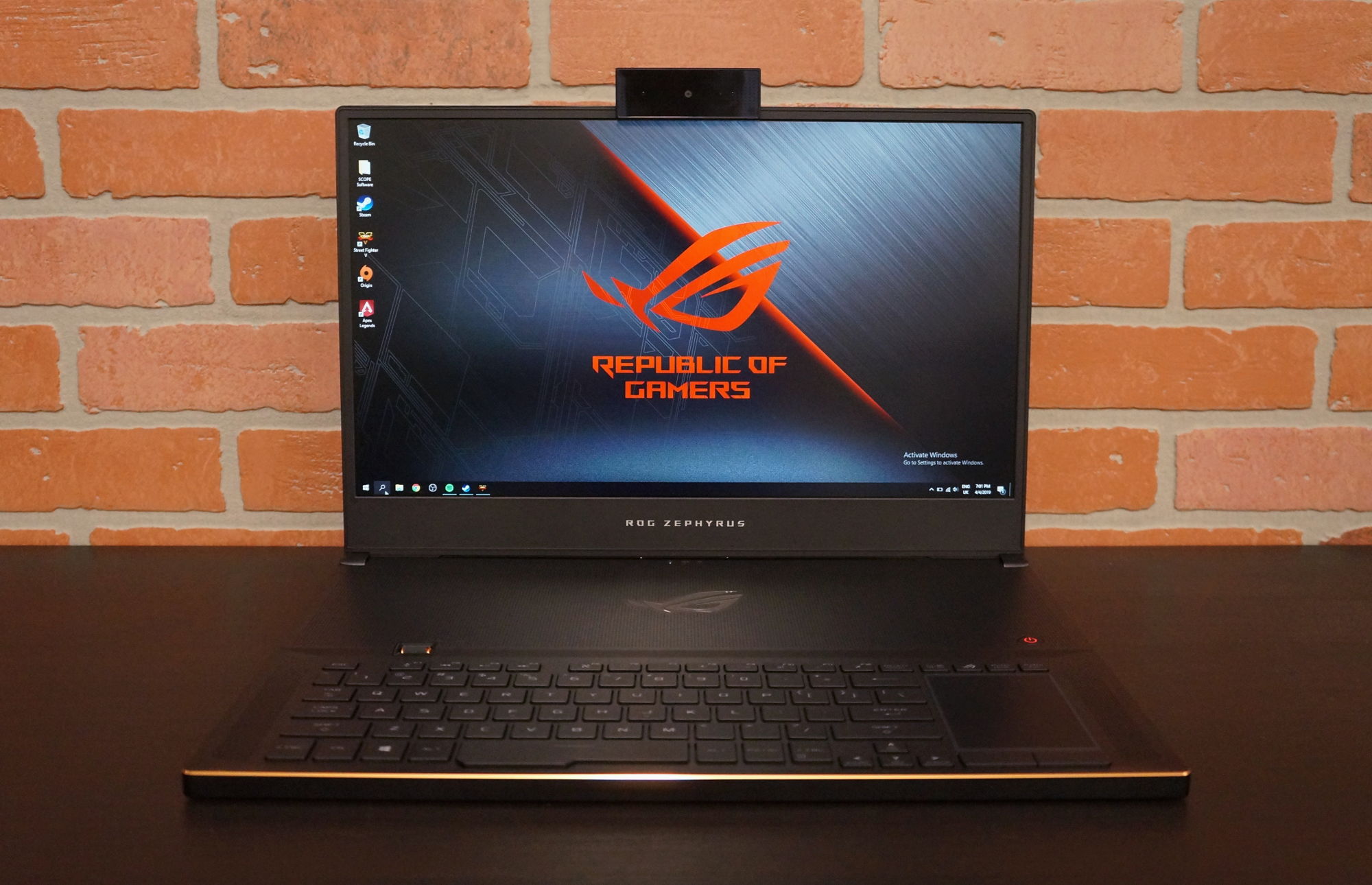
The combination of GeForce RTX 2080 and a high-refresh FHD panel is great for generating fluid frame rates. But you can’t always count on 144 FPS in cutting-edge titles like Metro Exodus with real-time ray tracing enabled. That’s why we’ve armed Zephyrus S GX701 with G-Sync support, allowing the display to vary its refresh rate based on the graphics module’s output. Frames are displayed when they are rendered. You never see the tearing that results when multiple frames are stitched together in a single refresh or the stuttering that indicates the graphics subsystem is trying to catch up. Gamers who already own a desktop monitor with G-Sync built-in know that the technology has a huge experiential impact, and being able to benefit from it on your laptop makes gaming away from home that much more enjoyable.
When you’re not gaming, there’s no reason for the 100W discrete GPU to siphon power from the GX701’s battery. Unique support for NVIDIA’s Optimus technology lets the system disengage its GeForce and switch over to Intel’s UHD Graphics 630 engine for serious savings. Generally, this wouldn’t be possible—you’d need to pick a laptop with G-Sync or Optimus support, but not both. We implemented a special switch that makes their coexistence possible, though. Simply press the ROG logo key or open the Armoury Crate utility, tab over to Device Configuration, and click the GPU Mode icon to turn off G-Sync and enable NVIDIA’s Optimus mode. You’re informed that activating Optimus requires a reboot. Click Yes to proceed and allow the GX701 to reconfigure itself. The discrete processor steps aside, giving Intel’s integrated graphics processor the reins for video playback and motoring around online. The same process, reversed, engages the GeForce RTX 2080 exclusively—a necessary step to synchronize the GPU and display via G-Sync.

This ability to toggle between G-Sync and Optimus is absolutely critical to the GX701’s double life as a gaming beast and road warrior’s sidekick. Plugged in to wall power, ROG’s Zephyrus S is a speed demon with all the accoutrements of a high-performance PC. Opened on a tray table or in the corner of a crowded café, it’s ready for Office duty without the anxiety that goes along with big engines and mlittle gas tanks.
The power to compute and intelligence to endure
This version of the Zephyrus S GX701 centers on an 8th-gen Intel Core i7-8750H host processor. The six-core chip boasts Hyper-Threading technology, so it can crunch on 12 software threads at a time. A peak Turbo Boost clock rate of 4.1GHz and generous 9MB of L3 cache easily land in high-end desktop territory. And yet, its 45W thermal design power defers to long battery life and compact form factors.
The secret to this CPU’s success is a snappy response whenever you call upon it for performance, and it’s helped along with a set of HyperFan profiles that dictate its behavior. If you’re in the library studying, open up Armoury Crate and click Silent to throttle clock rates (and fan speeds) down. I spent most of my time testing on AC power using the Balanced profile. This kept the Core i7 running at around 4GHz, so any application I opened popped right up. Turbo and Manual options pave the way to even better performance if you want to toy with overclocking. Right out of the box, though, the GX701 made all of the right moves on its own, spinning down to near-silence at idle and ramping up to cope with heat during extended gaming sessions.
Unplugged from the wall, I watched the Turbo and Manual profiles disappear from Armoury Crate. You wouldn’t want to use those on battery power, so they’re removed from the menu. The remaining Silent and Balanced options changed their behaviors to stretch available power out as far as possible. The former dropped my Core i7’s clock rate to a fairly constant 1.1GHz, leaving it plenty snappy for word processing and Web browsing, while the latter allowed a 1.9GHz clock rate for generally better performance if you’re multitasking on the road.
A modern Intel HM370-based platform is configured with 16GB of DDR4-2666 memory, complementing the GeForce module’s 8GB of GDDR6. A handful of NVMe-based SSD options ensure your GX701 includes at least 512GB of solid-state storage. The 1TB drive in my Zephyrus is especially deluxe, though. Even after loading up our modern benchmark suite, more than 600GB of free space left plenty of room for additional games and movies. Applications launch as fast as I can click on them thanks to a four-lane PCIe 3.0 interface able to read sequentially at up to 3.2 GB/s.
Keep your cool
Adding up the power consumption of components inside ROG’s Zephyrus S GX701 quickly gets you to a figure that doesn’t seem plausible from a mobile design, much less a laptop measuring 0.7” thick. Just the CPU and GPU together approach 150W. Since we already know from our benchmark results that ROG’s rubber really meets the road and that the GX701’s amazing performance is no illusion, how does the system keep cool under the stress of high-end gaming?
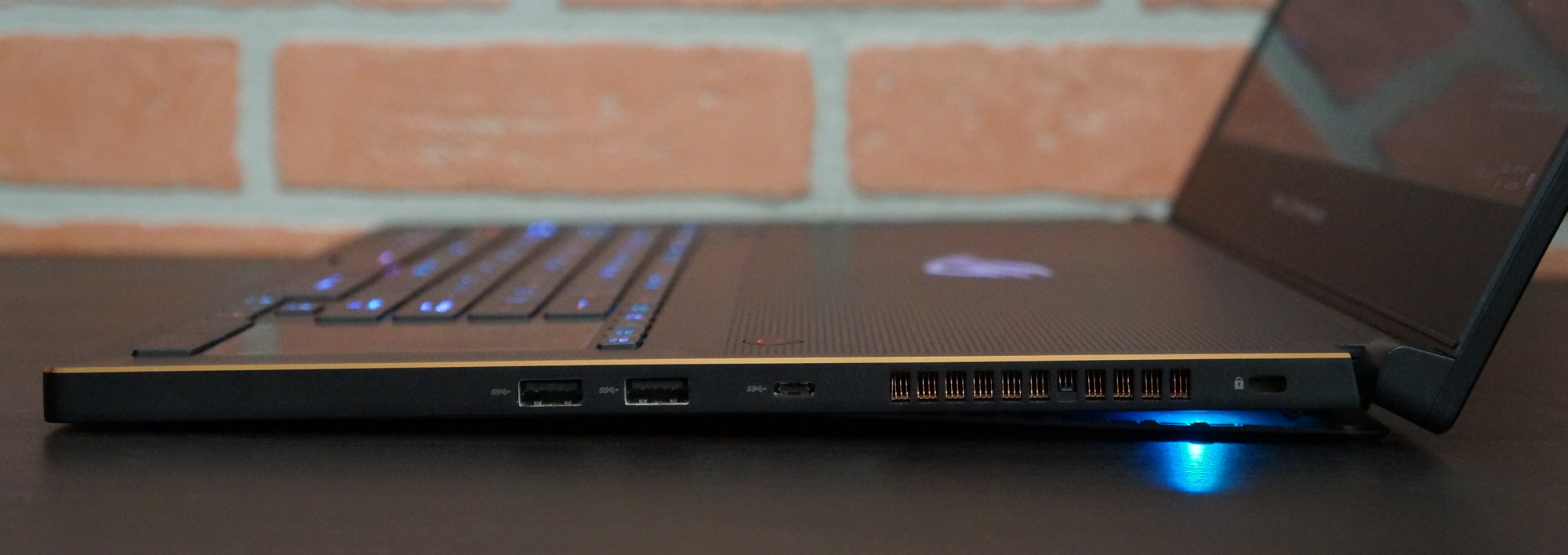
Central to its design is the Active Aerodynamic System, or AAS, which pushes the Zephyrus S’ bottom panel down as you open its lid. The 6 mm gap that forms becomes a cold air intake of sorts, keeping the fans inside fed with ample flow. Open and close, open and close. Watching the GX701 rise and hunker down over and over becomes mesmerizing. It also proved to me that the lid, bottom panel, and hinge are incredibly sturdy. Despite their thin construction, premium, precision-finished materials held shape throughout testing.
Air is drawn in through the bottom and small holes above the keyboard by a pair of 83-blade fans constructed from a special liquid crystal polymer meant to withstand high temperatures and rotational speeds. The fans blow this cool air through four sinks visible on three of the GX701’s sides. A series of five heat pipes covering the laptop’s warmest components move thermal energy into those arrays of copper fins.

This engineering work is brutally effective. I looped our Metro Exodus benchmark five times in a test that lasted more than 10 minutes. NVIDIA’s GeForce RTX 2080 was pegged close to 100% utilization. Its TU104 processor started the experiment cool, at about 60°C, and at a 1,530 MHz clock rate. By the end, it heated up to 78°C, but was still bouncing around between 1,500 and 1,530 MHz.
There’s enough sophistication in the Zephyrus S cooling system to warrant moving its keyboard down into the body’s lower half. So, it’d also seem to be susceptible to degradation over time if that 6mm intake sucked up too much dust. Fortunately, special channels capture particles and redirect them out the chassis before they’re able to settle in one of the radiators.
Putting control front and center
ROG’s Zephyrus S GX701 is the first laptop I’ve ever used with a keyboard butting up against the front edge and a touchpad shifted over to the side. It took going hands-on with the GX701 to make me a convert. However, the layout is actually quite natural. The thin chassis is easy to reach over with my palms resting on the table in front of it, and a slight incline created by the Active Aerodynamic System replicated the angle I prefer on my gaming desktop with its keyboard’s feet deployed.
Although I have small hands, I was able to easily extend out to hit the number keys. Only the function keys up top required coming up off the table to press. The space bar down below is thicker on the left side, making it easier to strike without looking. And a volume wheel above the keyboard enables easy adjustments with tactile resistance. Pressing down mutes the audio altogether. While it’s true that the forward-sitting keyboard creates more room for fans, ROG’s layout also puts the laptop’s input south of its hottest components rather than on top of them. Consequently, your hands stay nice and cool, even during the heat of battle.
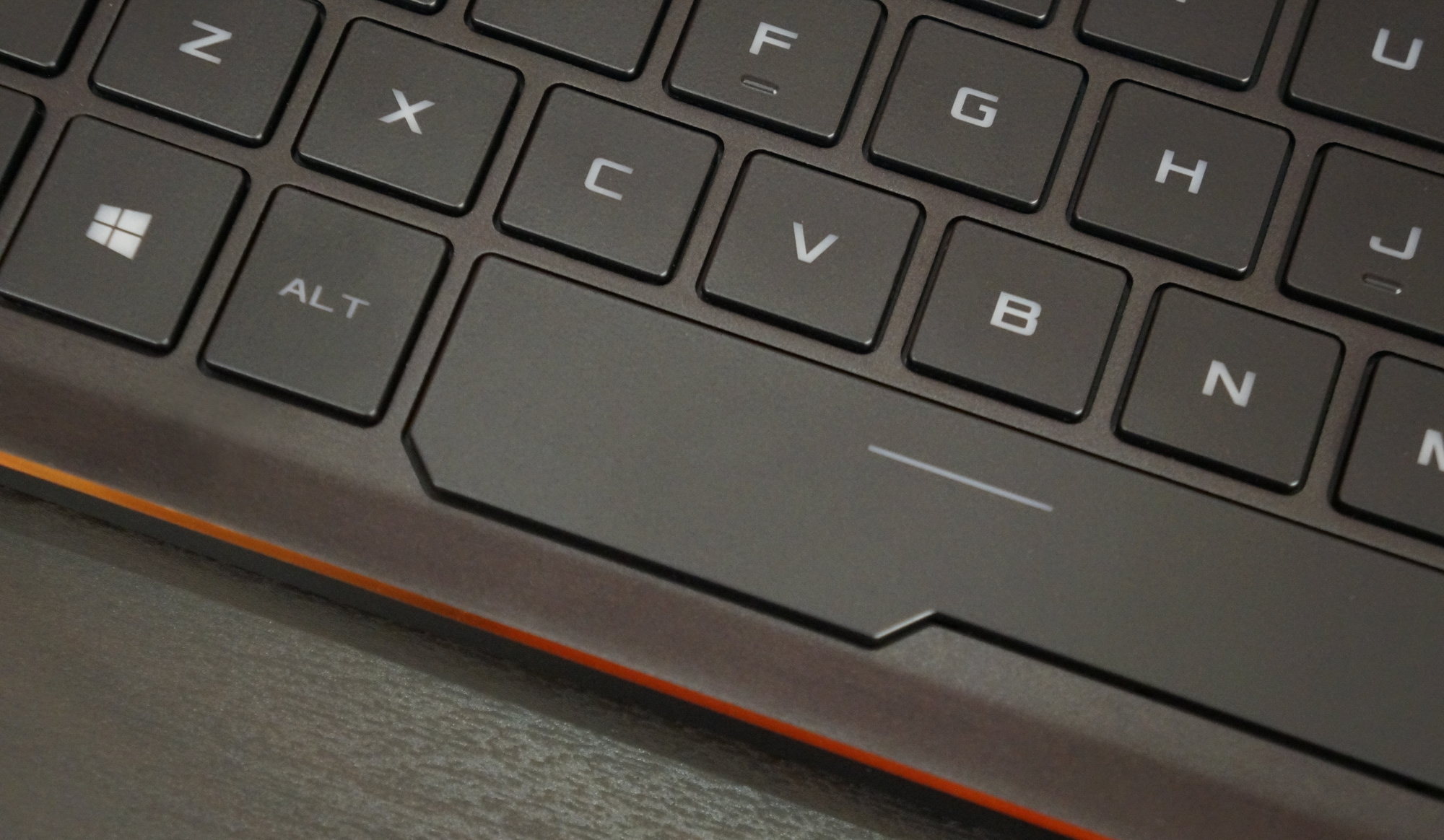
Even more surprising than my fondness for the GX701’s typing surface was the positioning of its touchpad. Nestled next to the keyboard, I found it far faster to control the mouse with my right hand compared to pads traditionally located below the keyboard. I also appreciated the distinct left- and right-click keys, which left less room for ambiguity than the all-in-one clicky pads that are becoming more popular.
It took a few hours before I considered myself acclimated to using the Zephyrus S GX701’s keyboard and a USB mouse for fast-paced gaming. Switching from a full-sized gaming keyboard to the GX701’s chiclet-style keys with 1.4 mm of travel did take a bit of mental recalibration, but I was helped along by the customizable Aura RGB backlighting. Again, using Armoury Crate, I toyed around with some of the universal effects applied to the whole keyboard. Then I tore into the customizable profiles, which allowed me to assign per-key colors for a bit of illuminated hotkey guidance in dimly lit rooms. I also discovered that, with a mouse attached, it makes more sense to turn the touchpad into a number pad by pressing the corresponding button above it.
Let’s hook up
Most everything you could want from a gaming PC is already built into the Zephyrus S GX701, but the right peripherals make it even better. A mouse, for example, is a must-have. Grab an Aura Sync-compatible model like the Gladius II and use Armoury Crate to coordinate its colors with the keyboard. The GX701 sports one USB 3.1 Gen2 Type-A port (10 Gb/s) and two USB 3.1 Gen1 Type-A (5 Gb/s) ports to accept your input device of choice (in addition to the optional 1080p60 webcam or a couple of VR tracking stations). On the chassis’ left side, a USB 3.1 Gen2 Type-C port supports DisplayPort signals and USB Power Delivery.
If you’re on the road and only planning to do a bit of word processing or web browsing, a 65W Type-C adapter tucked into your laptop bag will keep the GX701 topped off. Once you get home and roll up your sleeves for some serious gaming, you can switch to the 230W external power supply to deliver the juice required for full-throttle playtime. You can also use the Type-C port to drive one external monitor via DisplayPort and a second screen over the full-size HDMI 2.0 port. Both interfaces support 4K monitors at 60Hz. The HDMI output can also be used for virtual reality if you want to push your gaming experiences into new territory.
In lieu of wired Ethernet, the GX701 incorporates an M.2-attached Intel Wireless-AC 9596 module in a 2x2 MU-MIMO configuration. Its maximum theoretical throughput of 1.73 Gb/s blasts past anything you’d see from a gigabit connection to the wall, so long as you pair it to a compatible router like the ROG Rapture GT-AC5300.
The only other connectors on the GX701’s side are a DC power input and a 3.5-mm headphone/mic combo jack. It’s a clean layout that simultaneously makes room for the most meaningful add-ons and peripherals.
Smile, you’re on camera
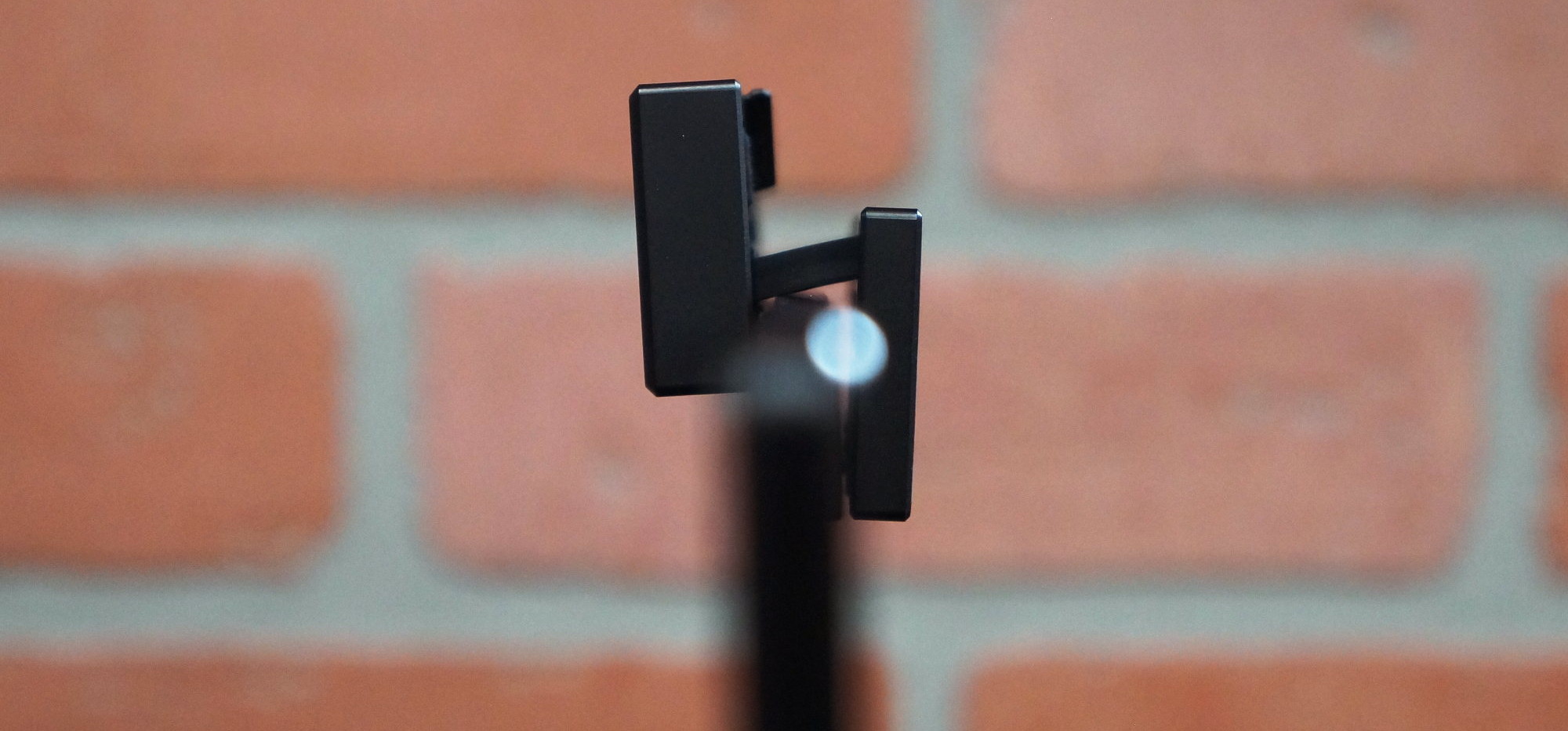
I’m fine jumping on conference calls first thing in the morning, but I dread video chats. The webcam atop my desktop monitor is lackluster, it refreshes slowly, and it can’t seem to get the lighting right. Most of the time, I face the thing backwards so that I’m never caught unprepared when it springs to life. It was a happy coincidence, then, when I opened the Zephyrus S GX701’s packaging and discovered the ROG GC21 webcam bundled as an optional extra.
You see, the GX701’s bezels are too thin to integrate a CMOS sensor, and a camera added under the display would peer intrusively up your nose. The GC21 equips ROG’s Zephyrus S with a true premium webcam capable of 1920x1080 video at 60Hz. At the same time, you have the option of leaving home without if you prefer anonymity. Clip the camera to the GX701’s top edge for front-facing exposure or mount it somewhere else for a different angle. It comes with a three-foot cable, giving you plenty of room to adjust its orientation.
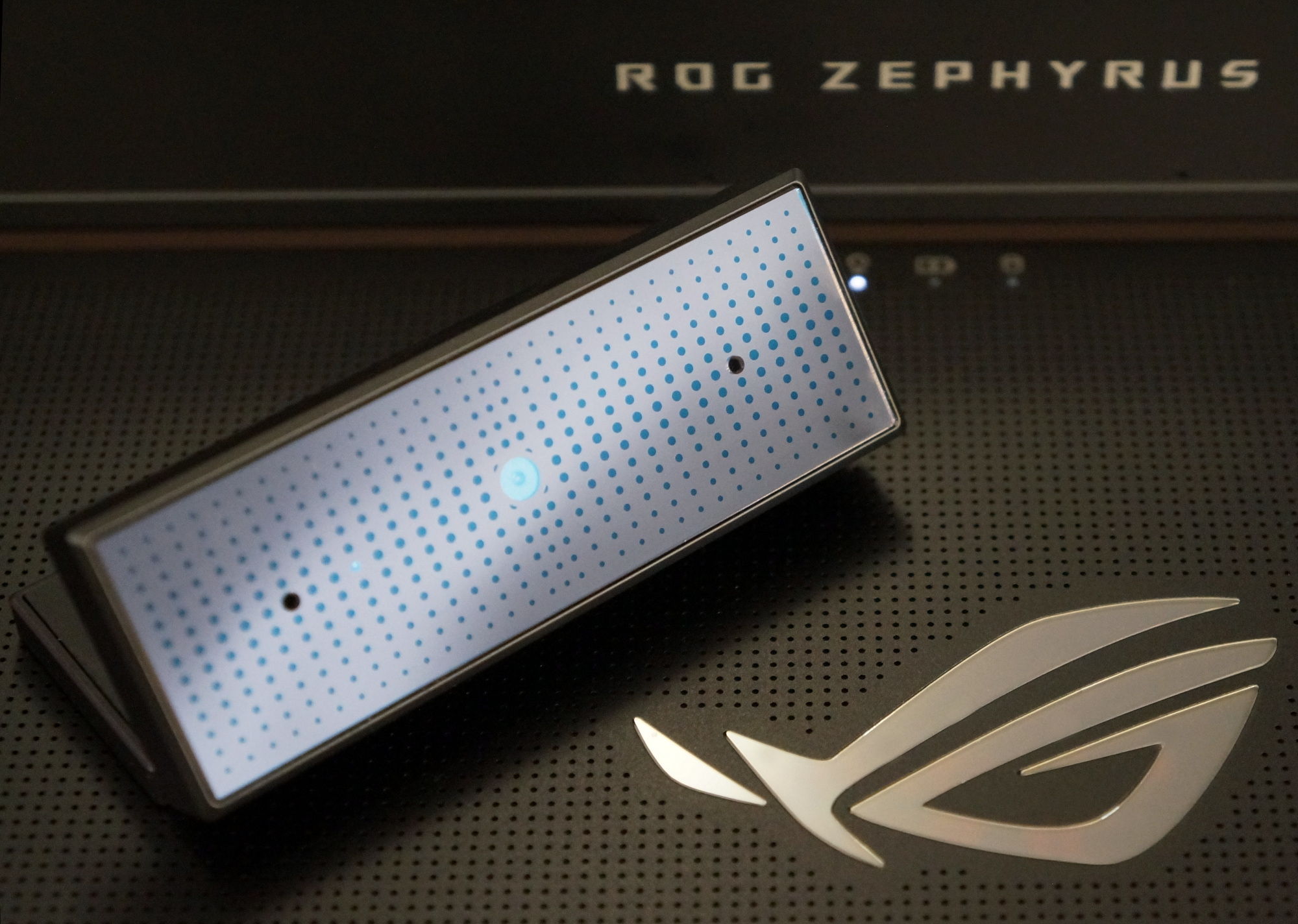
I set the webcam up for Skype chatting and thoroughly enjoyed the improvement in quality compared to my workstation’s camera. I still don’t want to stare into a lens at 7:00 AM though, so I folded the GC21 back down into its thumb drive-like form factor and tucked it away when I wasn’t using it. Someday I’ll get into Twitch streaming, or maybe I’ll try my hand as a YouTube creator, and the webcam, along with the six-core Core i7-8750H, and massive SSD will all play their part. For now, the camera can stay safely stowed in my laptop bag and is only part of my setup when I need it.
| ROG Zephyrus S GX701GX-XS76 | |
|---|---|
| Processor | 8th Gen Intel Core i7-8750H |
| Display | 17.3” FHD (1920x1080) IPS-level panel, 144Hz, 3ms GtG response time, 100% sRGB, Optimus, G-Sync, Pantone-validated |
| Graphics | NVIDIA GeForce RTX 2080 8G GDDR6 with (1330MHz boost clock @ 100W TGP) |
| Memory | 16GB DDR4-2666 |
| Storage | 1TB M.2 NVMe PCIe 3.0 x4 SSD |
| Wireless | 802.11ac 2x2 WLAN Bluetooth 5.0 |
| Connectivity | 1 x USB 3.1 Gen 2 Type-C with DisplayPort 1.4 and Power Delivery, 1 x USB 3.1 Gen 1 Type-C, 1 x USB 3.1 Gen 2 Type-A, 2 x USB 3.1 Gen 1 Type-A, 1 x HDMI 2.0b, 1 x 3.5mm headphone and microphone combo jack, 1 x Kensington lock |
| Keyboard | Per-key Aura Sync RGB backlighting, 1.4mm travel distance, N-key rollover |
| Audio | 2 x 2.5W speakers with Smart Amp technology Array microphone |
| OS | Windows 10 Pro |
| Size | 39.9 x 27.2 x 1.87 cm |
| Weight | 2.7 kg |
| Price | $3,299.99 USD $4,299.00 CAD |
| Availability (USA) | ASUS Store, Newegg, B&H, Amazon, Best Buy, Adorama, ExcaliberPC, Mobile Advance, iBuyPower, XoticPC, HID Evolution, CUK, GenTech, Pro Star |
| Availability (Canada) | Newegg.ca, Canada Computers, Memory Express |
A technological enigma
It’s hard to tell what the Zephyrus S GX701 is or what it can do by looking at a picture. A slim chassis belies the power inside. Narrow bezels around the display convey a sense of style rarely complemented by cutting-edge panel technologies. And a look at the GX701’s spec sheet might make you assume that this laptop is only good when its 230W AC adapter is plugged into the wall.
It’s true that ROG’s Zephyrus S is an absolute beast thanks to its six-core CPU, unrivaled graphics processor, PCIe-attached SSD, and gigabit-class wireless networking. But it’s not all brawn. The GX701 has intelligence, too. With Optimus mode enabled and the Balanced profile selected in Armoury Crate, I set the laptop up in my backyard and streamed a Blu-ray-quality copy of 2015’s Furious 7 using Plex. After the movie ended, two hours and 11 minutes later, I still had 43% of the battery remaining. There are thin-and-light notebooks with mainstream hardware in my lab that don’t last as long.
This is one flagship gaming laptop you’ll want to try for yourself. Gamers in North America can find the GX701 at the retailers listed in the table above. If you're outside North America, check with your local ROG representative for pricing and availability in your region.
By Paul Cross




